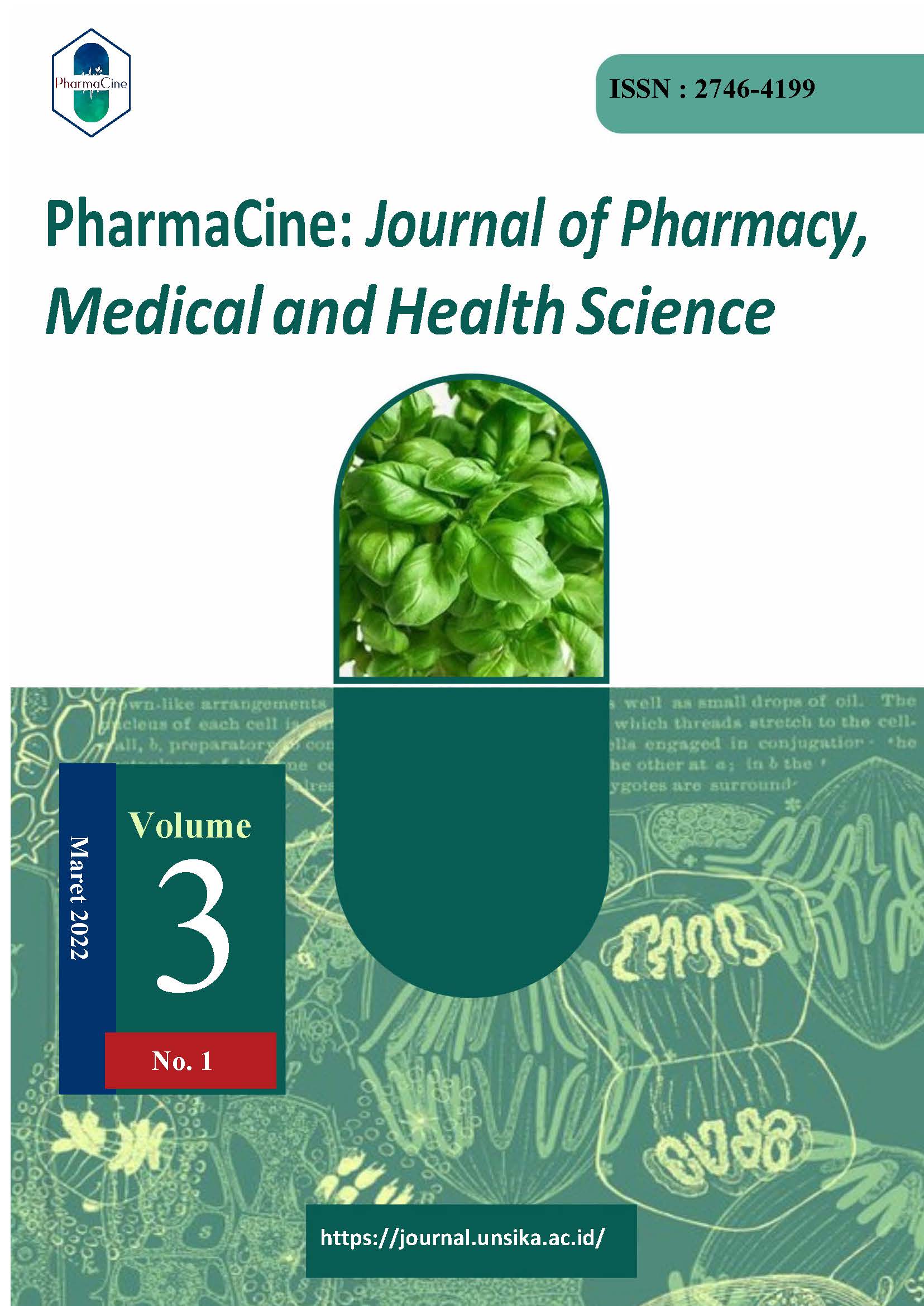Perbandingan Efisiensi Sintesis Senyawa 1,2-Difenil-4-Trifluorometil-3,5-Pirazolidindion dengan Teknik Refluks dan Radiasi Microwave
Main Article Content
Abstract
Latar Belakang: Senyawa 1,2-difenil-4-trifluorometil-3,5-pirazolidindion merupakan senyawa turunan 5-pirazolidindion yang berdasarkan hasil penelitian secara in silico berpotensi sebagai inhibitor selektif COX-2. Tujuan dan Metode: Penelitian ini bertujuan untuk membandingkan efisiensi sintesis senyawa 1,2-difenil-4-trifluorometil-3,5-pirazolidindion dengan teknik refluks dan teknik radiasi microwave. Sintesis senyawa dilakukan dengan mereaksikan senyawa 1,3-dietil- 2-trifluorometil-propandioat dengan hidrazobenzen dalam pelarut metanol dalam kondisi asam (HCl). Hasil: Hasil sintesis diperoleh senyawa berbentuk serbuk hablur berwarna ungu kebiruan (teknik refluks) dan berwarna ungu keabuan (teknik radiasi microwave). Bobot hasil sintesis senyawa dengan teknik refluks adalah 1,239±0,005 g dan dengan teknik radiasi microwave adalah 2,306±0,007 g. Ada perbedaan secara bermakna antara bobot hasil sintesis senyawa dengan teknik refluks dan teknik radiasi microwave (t hitung > t tabel, P = 0,99). Berdasarkan hasil KLT, senyawa hasil sintesis dengan teknik radiasi microwave lebih murni (satu bercak) dibandingkan dengan teknik refluks (tiga bercak). Berdasarkan pemantauan dengan spektrofotometri UV dan Inframerah, ada kemiripan bentuk spektrum senyawa hasil sintesis dengan teknik refluks (λmaks 290,9 nm) dan teknik radiasi microwave (λmaks 288,3 nm). Simpulan: Sintesis senyawa dengan teknik radiasi microwave lebih efisien dibandingkan dengan teknik refluks.
Kata Kunci : 1,2-difenil-4-trifluorometil-3,5-pirazolidindion, sintesis, refluks, radiasi microwave
Downloads
Article Details
Authors who publish in PharmaCine: Journal of Pharmacy, Medical and Health Science agree to the following terms:
- Authors retain copyright and grant the journal right of first publication with the work simultaneously licensed under a Creative Commons Attribution-ShareAlike 4.0 International License that allows others to share the work with an acknowledgment of the work's authorship and initial publication in this journal.
- Authors can enter into separate, additional contractual arrangements for the non-exclusive distribution of the journal's published version of the work (e.g., post it to an institutional repository or publish it in a book), with an acknowledgment of its initial publication in this journal.
- Authors are permitted and encouraged to post their work online (e.g., in institutional repositories or on their website) prior to and during the submission process, as it can lead to productive exchanges, as well as earlier and greater citation of published work (See The Effect of Open Access).
PharmaCine : Journal of Pharmacy, Medical and Health Science by https://journal.unsika.ac.id/ is licensed under a Creative Commons Attribution-ShareAlike 4.0 International License.
You are free to:
- Share, copy and redistribute the material in any medium or format
- Adapt, remix, transform, and build upon the material for any purpose, even commercially.
- The licensor cannot revoke these freedoms as long as you follow the license terms.
References
Landelle, G., Panossian, A., Pazenok, S., Vors, J. P., & Leroux, F. R. Recent advances in transition metal-catalyzed Csp2-monofluoro-, difluoro-, perfluoromethylation and trifluoromethylthiolation. Beilstein Journal of Organic Chemistry. 2013; 9: 2476–2536.
Ma, J. A., & Cahard, D. Mild Electrophilic Trifluoromethylation of β-Ketoesters and Silyl Enol Ethers with 5-Trifluoro Methyldibenzothiophenium Tetrafluoroborate. Journal of Organic Chemistry. 2003; 68(22): 8726–8729.
Zhang, C., Chen, Q., Guo, Y., Xiao, J., & Gu, Y. Difluoromethylation and trifluoromethylation reagents derived from tetrafluoroethane-sultone : Synthesis, reactivity and applications. Coordination Chemistry Reviews. 2014; 261: 28-72.
Zhu, W., Wang, J., Wang, S., Gu, Z., Aceña, J. L., Izawa, K.,Soloshonok, V. A. Recent advances in the trifluoromethylation methodology and new CF3-containing drugs. Journal of Fluorine Chemistry. 2014; 167: 37–54.
Tiwari, A., and Singh, A. Synthesis and Antinociceptive Activity of Novel Mannich Base Derivatives of Some New Fused 3 , 5 ‑ Pyrazolidinedione. Journal of Advanced Pharmaceutical Technology & Research. 2014; 5(1): 41–47.
Anugrah, R, Suryasaputra D dan Mazuki, M. Desain Senyawa Turunan 3.5-Pirazolidindion dan Kajian Potensinya sebagai Inhibitor Selektif Siklooksigenase 2 secara In Silico. Laporan Penelitian LPPM UNJANI. 2018: 26.
Tiwari, A., and Singh, A. Synthesis Of New Pyrazolidine 3,5 Dione Derivatives Of Potential Analgesic, Antipyretic And Anti-Inflammatory Activities. Middle-East Journal of Scientific Research. 2013; 17(7): 926–935.
Suma, B. V., Rochani, A. K., Venkataramana, C. H. S., Jays, J., & Madhavan, V. (2010). Synthesis, Characterization, Invitro Antibacterial, Anti-inflammatory Evaluations of Novel 4-quinolone Containing Pyrazolidinedione Derivatives. International Journal of ChemTech
Research. 2010; 2(4): 2156–2162.
Florey, K. Analytical profiles of drug substances. Toxicon. London, UK: Academic Press.1982; 11: 484-486.
Fessenden, R.J., Fessenden, J.S. Dasar-Dasar Kimia Organik. Alih Bahasa: Maun, Sukmariah dkk. Jakarta: Binarupa Aksara. 1997; 551-552.
Gandjar, I.G dan Rohman, A. Kimia Farmasi Analisis. Yogyakarta: Pustaka Pelajar. 2007; 240.
Pavia, D.L., Lampman, G.M., Kriz, G.S., dan Vyvyan, J.R. Introduction To Spectroscopy, 4 th Edition. US: Nelson Education. 2009; 29-30.
Rohman, Abdul. Statistika dan Kemometrika Dasar dalam Analisis Farmasi. Yogyakarta: Pustaka Pelajar. 2014; 84-87.

